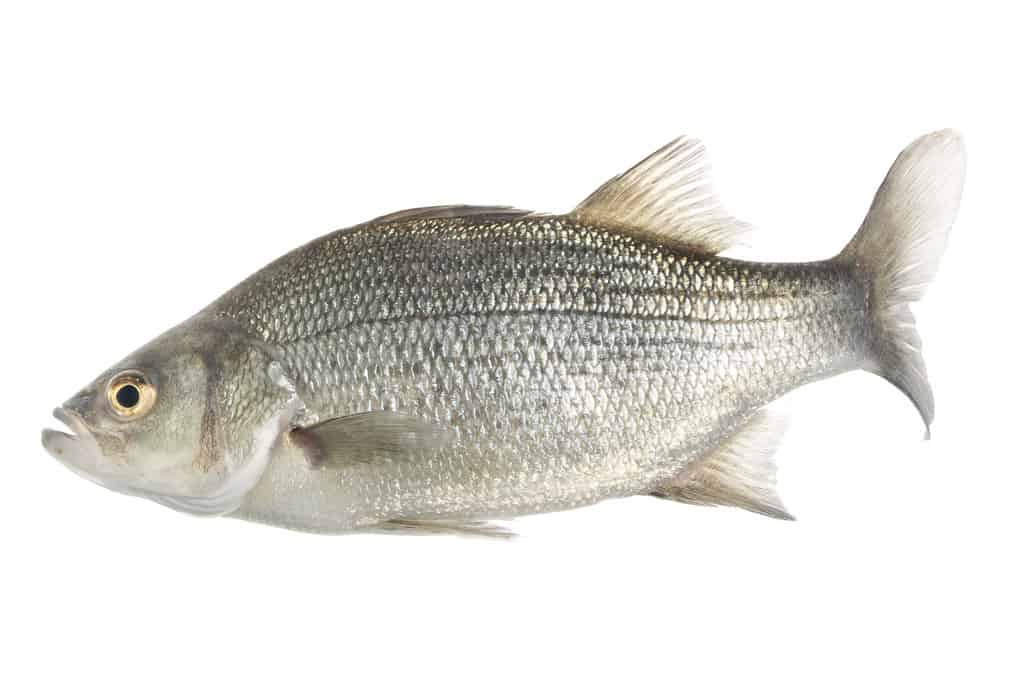White bass is a popular fish to catch for anglers as it can also be eaten, but it has a very fishy taste that is not appealing to most.
Advertisement
White Bass Scientific Classification
- Kingdom
- Animalia
- Phylum
- Chordata
- Class
- Actinopterygii
- Order
- Perciformes
- Family
- Moronidae
- Genus
- Morone
- Scientific Name
- Morone chrysops
Read our Complete Guide to Classification of Animals.
White Bass Conservation Status
White Bass Facts
- Prey
- smaller fish, crustaceans, insects
- Main Prey
- opportunistic feeder
- Name Of Young
- fry
- Group Behavior
- School
- Fun Fact
- White bass is a popular fish to catch for anglers as it can also be eaten, but it has a very fishy taste that is not appealing to most.
- Estimated Population Size
- 10 million
- Biggest Threat
- Overfishing
- Most Distinctive Feature
- Silver-white coloring
- Other Name(s)
- Sand bass, silver bass
- Average Spawn Size
- 500,000
- Predators
- other bass species, birds, other white basses
- Diet
- Carnivore
- Lifestyle
- School
- Common Name
- White bass
- Slogan
- Silvery white fish popular with anglers
- Group
- School
View all of the White Bass images!
The white bass is a freshwater fish native to North America, and although it is often hunted for food, many people dislike its distinctive fishy taste.
The white bass is a freshwater fish that is native to North America. It is a popular game fish and is often consumed as food. It is found in lakes and rivers and can grow up to 12 inches in length. The white bass is an important fish and is quite popular among anglers. This fish has a silver-white body with dark vertical stripes. Its diet consists of smaller fish, insects, and crustaceans. It spawns in the spring, and the female can lay up to 500,000 eggs.
5 Incredible White Bass Facts
- They are a member of the temperate sunfish family and are closely related to the striped bass.
- They are found in freshwater lakes and rivers throughout North America.
- They are popular among fishermen and are considered good table fare.
- They typically grow to be around 12 inches long and weigh 1-2 pounds.
- The world record white bass was caught in 1989 and weighed in at six pounds, 13 ounces!
Scientific Name
Morone chrysops is commonly known as the white bass, the sand bass, and the silver bass. It is unknown where the word “morone” comes from, but “chrysops” is the Greek word for “golden eye.” The white bass’s scientific name refers to the yellow eye of the fish.
White Bass Appearance

Despite their name, white bass are silver colored.
©”White bass” by USFWS Mountain Prairie is marked with Public Domain Mark 1.0. – Original / License
This fish has a silver-white body with dark stripes running along its sides. It typically grows to be about 12 inches long and weighs 1-2 pounds. The belly of the fish is usually white or pale yellow. The back and upper sides of the fish are typically darker than the rest of the body. It is a relatively small fish; however, some individuals have been known to grow up to 18 inches in length and weigh four pounds.
Evolution
The white bass has undergone several evolutionary changes over the years. For example, it was once believed to be a direct descendant of the striped bass. However, recent DNA evidence has shown that this is not the case. Instead, it appears that the white bass and striped bass are more closely related to each other than they are to any other fish species.
In addition, scientists have also found evidence that suggests these fish may have evolved from two different ancestral populations. One of these populations was in what is now the eastern U.S., while the other was located in what is now western Canada. This evidence comes from a study of mitochondrial DNA, which showed two distinct genetic lineages within the white bass population.
Overall, this fish has undergone many evolutionary changes over time. However, further research is needed to understand its evolutionary history completely.
Behavior
These fish are known for their aggressive behavior and are often considered one of the most challenging fish to catch. They are highly migratory and travel long distances searching for food or spawning grounds. This makes them difficult to track and study. Despite their aggressive nature, they are popular among anglers due to their fighting ability when hooked. They are also considered good for eating, with a milder flavor than some other freshwater fish.
Habitat
The white bass is found in lakes, rivers, and streams throughout the U.S. It prefers clear waters with little or no vegetation. The white bass spawns when water temperatures reach 60 degrees Fahrenheit in the springtime. After spawning, the adults move into deeper waters, where they actively spend the summer months feeding. In the fall, it migrates back to shallower waters.
This fish prefers clear water with a moderate current. It is an opportunistic feeder and will eat a variety of food items, including insects, small fish, crustaceans, and baitfish. In terms of temperature, the white bass prefers colder waters but can also tolerate warmer temperatures if necessary.
They are known to be reasonably migratory creatures, moving around in large schools in search of food. This makes them a popular target for fishermen, as they can be relatively easy to catch in large numbers.
White Bass Diet
The white bass is an opportunistic feeder and will eat various foods available, including insects, small fish, and crustaceans. White bass are predators and feed on these creatures due to their hunting ability. They are also known to eat other white basses when lacking food, making them difficult to keep together in captivity.
They are opportunistic feeders, making them very adaptable to different environments. However, their diet does vary depending on where they live. For example, white bass that live in streams tends to eat more insects than those living in lakes. Overall, the diet of the white bass is quite varied. They can adapt to different environments and eat whatever readily available food.
What Eats the White Bass?
Some predators include large birds and large marine animals, such as other bass species and birds like herons and gulls. They are also preyed upon by other white bass and humans.
What Does the White Bass Eat?
They will eat whatever is available but mainly insects, small fish, and crustaceans.
White Bass Predators and Threats
The white bass is prized for its fighting ability and delicious taste. However, this fish has its predators and threats too. The main predators of the white bass are other fish, such as the largemouth bass and the smallmouth bass. These fish often eat smaller white bass or prey on them when spawning. Birds such as gulls, loons, cormorants, and herons will also feed on white bass.
There are also several human-related threats to their population. Overfishing is a significant problem for this species as they are often caught for sport or food. Pollution and habitat destruction can also negatively impact the white bass population. Despite these challenges, they remain a popular sport fish due to their abundance in many areas and their tasty flesh. With proper management and conservation efforts, we can ensure that this species continues to thrive for generations.
White Bass Reproduction
White bass reproduce in late spring when water temperatures reach 60-65 degrees Fahrenheit. A female can lay up to 500,000 eggs per season. During this time, the fish will migrate to shallow waters where they will spawn. The female will release her eggs into the water, and the male will then fertilize them. After spawning has occurred, the parents will return to deeper waters.
Their eggs are adhesive, meaning they will stick to objects in the water, such as rocks or plants. Once hatched, the larvae of the fish are tiny and are difficult to see with the naked eye. They will remain in shallow waters until they reach a larger size, at which point they will move into deeper waters where they will live for the rest of their lives.
White Bass Babies
The fry (baby fish) hatch within two days and grow fast, reaching sexual maturity within 2-3 years and reaching adulthood within one year. The young fish will feed on small insects and other organisms. The fry will then search for schools for protection. At this point, they will start to move into open water, feeding on small crustaceans, insects, and larvae. The fry can reach lengths of 10 inches within their first year.
White Bass Lifespan
These fish have an average lifespan of 4-5 years. They are known to be hardy fish and can withstand a wide range of water conditions. The main factors that affect the lifespan are water quality, diet, and predation pressure. In wild populations, predation pressure is also a significant factor affecting mortality rates. Some threats include:
- Predators
- Disease
- Habitat loss
- Humans
Population
The white bass is a popular game fish, and they are also commercially harvested. The estimated global population of this species is around 10 million. However, there is no reliable estimate for the total number of white bass in the wild. The population numbers of this species have likely declined in recent years due to overfishing and habitat loss. The exact extent of these declines is unknown. Despite these challenges, it remains an integral part of the ecosystem and economy in many parts of North America.
White Bass in Cooking
This is one of the most popular fish to catch, as it is also a tasty treat for an angler after a long day by the shores. There are many ways to prepare it, including grilling, smoking, or deep frying. You can pan-fry this fish with light seasoning to bring out the flavor. Although the fillets will be relatively smaller compared to other popular game fish, the white bass can still be a good meal with some hearty sides and white wine.
The taste of this fish is often compared to that of crappie but with a completely different texture. White bass can taste a little fishy, so many people avoid eating this fish. However, with that said, the taste can easily be masked by cooking the fish correctly. The best way to prepare the fish is to grill it with good seasoning and breading. This fish also has a high oil content, making it flaky and moist, but it is not as oily as cod.
Similar Animals
View all 108 animals that start with WWhite Bass FAQs (Frequently Asked Questions)
Are white bass carnivores, herbivores, or omnivores?
The white bass is known to be a carnivore, as it eats other animals, such as other fish, crustaceans, and more.
Which countries are the white bass found in?
The white bass is mainly found in fresh bodies of water in North America.
What is the average lifespan of a white bass?
The average lifespan of the white bass in the wild is approximately five years.
Is white bass fish good for you?
White bass, like other white fish, are nutritious and healthy, containing protein and omega-3. This protein is relatively low-calorie, making it a great choice for those looking to lose a bit of weight.
Can you eat white bass raw?
Since white bass has a notoriously fishy taste, this fish may not be the best species to prepare and eat raw. Although not dangerous, it would simply not taste very good. White bass is best eaten by masking the flavor in some manner.
Is white bass high in mercury?
White bass is lower in mercury than most fish. It’s generally fish that are higher up on the food chain that are high in mercury.
Thank you for reading! Have some feedback for us? Contact the AZ Animals editorial team.


















